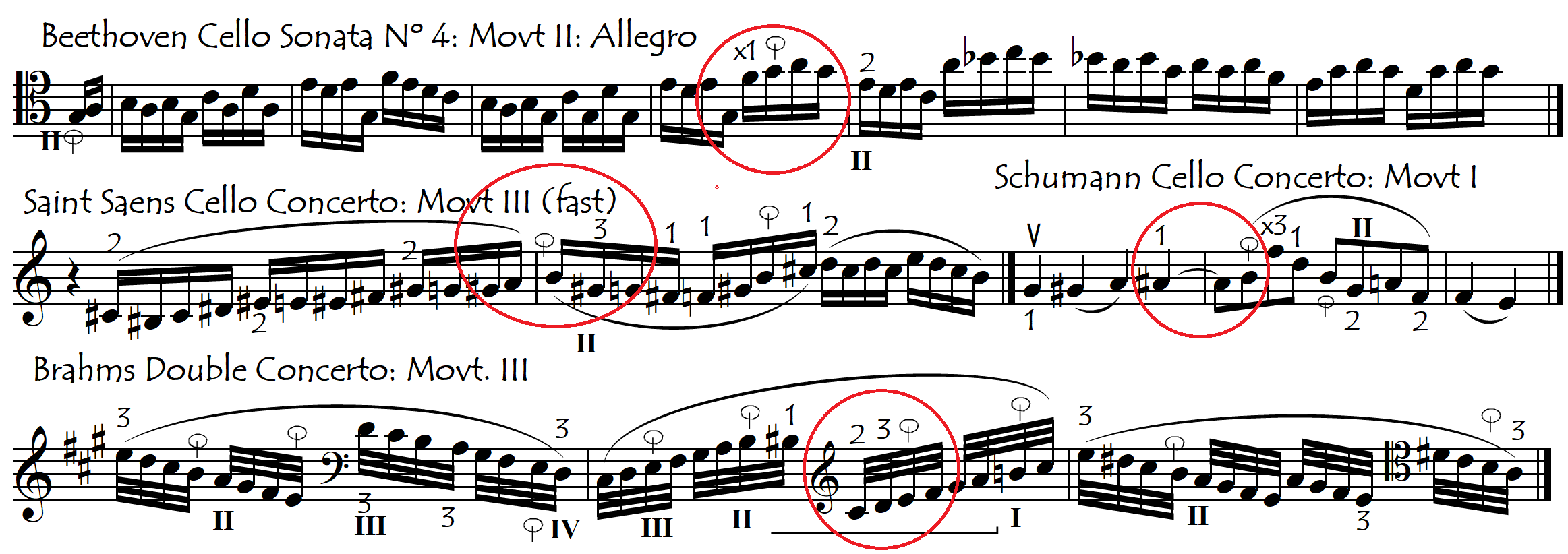Shifting On and To the Thumb
The side of the thumb (that part of the thumb that we use to stop the strings) is a very poor substitute for the fingertips. It not only has many fewer nerve endings than the finger pads but also has much less soft cushioning (meat) on it. These factors mean that it can seem (feel) – especially at first – quite unnatural and difficult, not only to play on the thumb, but even more so, to shift on (and to) the thumb. But with practice we soon overcome this feeling, and the thumb’s many advantages (great strength, mobility and stability), ultimately hugely outweigh these tactile deficiencies.
As with all the other fingers, the prerequisite skills for being able to comfortably shift to the thumb, are (in order of priority):
- to be absolutely comfortable simply playing on the thumb, and
- to be absolutely comfortable shifting on the thumb (same finger shifts on the thumb).
Thus, before trying to be good at shifting to the thumb, we need to first become very comfortable playing in basic thumbposition, and then subsequently we need to work on our shifting on the thumb (with no changes of finger during the shift). This “shifting on the thumb” is a technique that we use frequently – and from quite an early stage in cello playing level – in double-stopped passages. Most passages in octaves, thirds and fifths, (unlike sixths) would be unplayable (or horribly difficult) without the use of the thumb.
Shifting to the thumb is however one step more complicated than shifting on the thumb, as we need now to change from a finger to the thumb during the shift. What’s more, when we shift up to the thumb from the Neck Region or the Intermediate Region we have an additional level of complication, as here we need to place the thumb on top of the fingerboard, as well as do the shift and change the playing finger.
This may sound like a complicated and difficult virtuoso technique, but it’s not really. In fact we have been doing shifts to the thumb right from when we first started learning the thumbposition – but usually without even realising it. These are the “shifts” that we do systematically to get our arm and hand “in position” before we actually start playing in thumbposition (see Lefthand Positional Sense). Our use of the thumb here is simply as a navigation aid, a fingerboard GPS (SatNav), with which we establish and stabilise our hand’s correct pitch position in the different thumbpositions. In these shifts, we confirm the correct pitch of the hand by sounding the pitch of the thumb with a soft left-hand pizzicato before we actually start playing with the fingers. Thus we are using the thumb here as our “home base” (base camp) from which we can then easily find our fingers.
The following link opens a compilation of repertoire excerpts of this type:
We normally don’t consider these shifts as “true shifts” to the thumb because:
- they are usually silent,
- they are usually done with plenty of time (and therefore with no rhythmical constraints),
- we maybe don’t even play the actual note on the thumb until later in the passage (if at all).
This skill of “finding (shifting to) the thumb before the music starts“, is a perfect precursor to the skill of “shifting onto the thumb during a musical phrase”.
Learning to shift on (and to) the thumb is like learning so many other new skills: it seems impossible at first, but once we know how to do it we wonder how we ever managed to do without it. Being able to shift fast and fluently to the thumb can make passages that seemed impossible suddenly (relatively) easy. In the following examples, one fast little stepwise shift to the thumb gets us out of a whole lot of trouble. Sometimes the thumb really is like a magic wand – if we know how to use it!

We can classify (categorise) “Shifts To the Thumb” into three main levels of increasing complexity (difficulty):
1: Same-Finger Shifts On the Thumb
2: Shifts to the Thumb From Another Finger Already in Thumb Position
2.A: Assisted Shifts Down to the Thumb
2.B: Scale/Arpeggio-Type Shifts to and from the Thumb
3: Shifts Up To the Thumb From Another Finger in the Neck or Intermediate Regions
In these shifts, we will normally try and place the thumb on the fingerboard before we do the shift, as this eliminates one extra complication from the shift, thus allowing us to give our entire concentration to the shift’s intonation.
Click on the highlighted links for practice material, repertoire excerpts and more detailed analysis for each of these different shift types.
